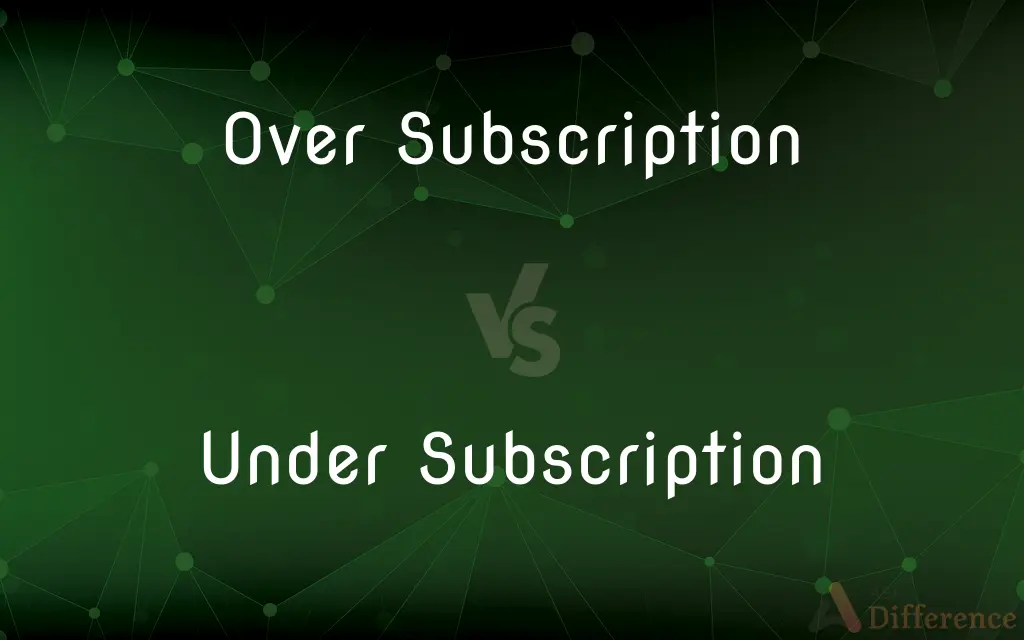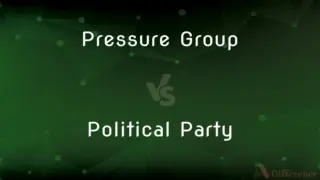Over Subscription vs. Under Subscription — What's the Difference?
By Tayyaba Rehman — Published on October 15, 2023
Over Subscription is when demand for a product or service exceeds the available supply. Under Subscription is when the demand for a product or service is less than what is available.

Difference Between Over Subscription and Under Subscription
Table of Contents
ADVERTISEMENT
Key Differences
Over subscription occurs when the demand for a particular product, service, or opportunity surpasses the quantity or availability that can be provided. Under subscription, on the other hand, takes place when the demand for a product, service, or offering falls short of the quantity that is available or has been offered.
Over subscription often leads to situations where more people or entities are interested in acquiring something than what is actually available. In financial markets, over subscription can result in the allocation of shares or securities through a lottery or pro-rata basis due to high demand. In Under subscription cases, there may be excess capacity or unsold items, which can lead to financial losses or the need to revise pricing strategies to stimulate demand.
Comparison Chart
Demand vs. Availability
Demand exceeds availability
Demand falls short of availability
Financial Implications
May lead to favorable pricing
May require price adjustments
Market Response
High demand, competitive scenarios
Lower demand, surplus capacity
ADVERTISEMENT
Allocation Mechanisms
Lottery, pro-rata allocation
Potentially excess inventory
Common Examples
IPOs, concert ticket sales
Clearance sales, surplus stock
Compare with Definitions
Over Subscription
Demand surpasses availability.
The concert tickets experienced over subscription, selling out within minutes.
Under Subscription
Limited interest in an offering.
The under subscription of the conference led to reduced registration fees.
Over Subscription
High demand for a limited supply.
The IPO saw significant over subscription, resulting in share allotment challenges.
Under Subscription
Insufficient demand for available units.
The under subscription of the housing development led to unsold properties.
Over Subscription
Excessive interest in a limited opportunity.
The scholarship program faced over subscription, necessitating a selection process.
Under Subscription
Demand falls short of availability.
The under subscription of event tickets left many seats vacant.
Over Subscription
Competitive demand exceeding supply.
The over subscription of hotel rooms during the holiday season raised prices.
Under Subscription
Less demand than expected.
The under subscription of the new product forced the company to reconsider its marketing strategy.
Over Subscription
More interest than what can be provided.
The new product launch led to over subscription, with orders exceeding production capacity.
Under Subscription
Low interest in a financial offering.
The bond issue experienced under subscription, resulting in unfilled orders.
Common Curiosities
What are the implications of over subscription?
It can lead to favorable pricing for sellers and allocation challenges.
What does over subscription mean?
Over subscription occurs when there is greater demand for a product or service than what is available.
Can you provide an example of over subscription in financial markets?
In an initial public offering (IPO), over subscription means more investors apply for shares than are available.
What is under subscription?
Under subscription occurs when there is less demand for a product, service, or offering than what is available.
What challenges can under subscription pose for businesses?
It may result in excess inventory, financial losses, or the need to revise marketing strategies.
How is over subscription typically managed in competitive scenarios?
It may result in lottery-based allocation or pro-rata distribution.
What happens in cases of over subscription for event tickets?
Tickets may sell out quickly, creating high demand and competition among buyers.
Can you provide an example of under subscription in retail?
An under-subscribed product may lead to clearance sales due to unsold inventory.
How does under subscription affect pricing?
It may require price adjustments, discounts, or incentives to stimulate demand.
How do companies address under subscription in the market?
They may implement marketing campaigns, lower prices, or offer incentives to boost demand.
Share Your Discovery

Previous Comparison
Quality Assurance vs. Quality Control
Next Comparison
Pressure Group vs. Political PartyAuthor Spotlight
Written by
Tayyaba RehmanTayyaba Rehman is a distinguished writer, currently serving as a primary contributor to askdifference.com. As a researcher in semantics and etymology, Tayyaba's passion for the complexity of languages and their distinctions has found a perfect home on the platform. Tayyaba delves into the intricacies of language, distinguishing between commonly confused words and phrases, thereby providing clarity for readers worldwide.














































